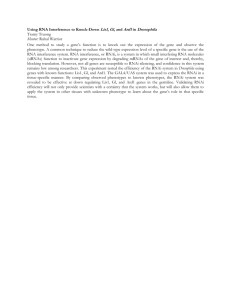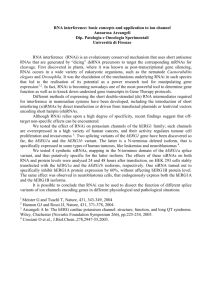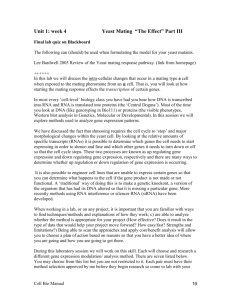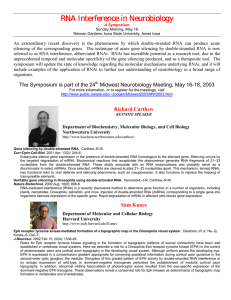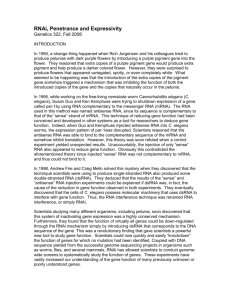Interfering with the genome: A new generation of disease treatments
advertisement
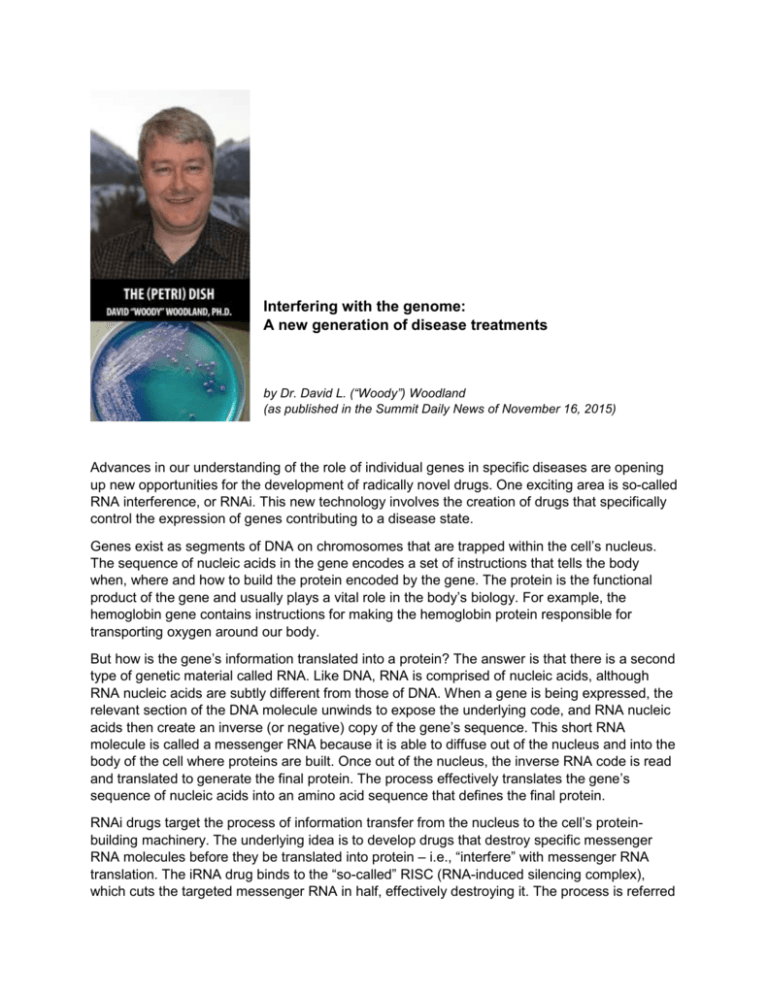
Interfering with the genome: A new generation of disease treatments by Dr. David L. (“Woody”) Woodland (as published in the Summit Daily News of November 16, 2015) Advances in our understanding of the role of individual genes in specific diseases are opening up new opportunities for the development of radically novel drugs. One exciting area is so-called RNA interference, or RNAi. This new technology involves the creation of drugs that specifically control the expression of genes contributing to a disease state. Genes exist as segments of DNA on chromosomes that are trapped within the cell’s nucleus. The sequence of nucleic acids in the gene encodes a set of instructions that tells the body when, where and how to build the protein encoded by the gene. The protein is the functional product of the gene and usually plays a vital role in the body’s biology. For example, the hemoglobin gene contains instructions for making the hemoglobin protein responsible for transporting oxygen around our body. But how is the gene’s information translated into a protein? The answer is that there is a second type of genetic material called RNA. Like DNA, RNA is comprised of nucleic acids, although RNA nucleic acids are subtly different from those of DNA. When a gene is being expressed, the relevant section of the DNA molecule unwinds to expose the underlying code, and RNA nucleic acids then create an inverse (or negative) copy of the gene’s sequence. This short RNA molecule is called a messenger RNA because it is able to diffuse out of the nucleus and into the body of the cell where proteins are built. Once out of the nucleus, the inverse RNA code is read and translated to generate the final protein. The process effectively translates the gene’s sequence of nucleic acids into an amino acid sequence that defines the final protein. RNAi drugs target the process of information transfer from the nucleus to the cell’s proteinbuilding machinery. The underlying idea is to develop drugs that destroy specific messenger RNA molecules before they be translated into protein – i.e., “interfere” with messenger RNA translation. The iRNA drug binds to the “so-called” RISC (RNA-induced silencing complex), which cuts the targeted messenger RNA in half, effectively destroying it. The process is referred to as gene silencing and, as might be expected, the genes being targeted by scientists are those involved in causing disease. Two leading RNAi drug candidates target the production of a mutant gene responsible for a disease called familial amyloid poly neuropathy. This disease is caused by a mutated gene that encodes a protein causing abnormal and damaging accumulation of proteins in the body’s tissues. It is anticipated that the first RNAi drug for this disease will hit the market in 2017. Other diseases potentially treatable with this technology include both infectious diseases, such as hepatitis B, and metabolic diseases, such as type 2 diabetes. Currently, most RNAi drugs under development are targeted to the liver, since the liver naturally absorbs RNA-based drugs. However, other organs could be targeted with more sophisticated approaches. One concept is to package the drug in a delivery vehicle, such as a nanoparticle or a benign virus engineered to target a particular organ or tissue. In the case of the viral delivery vehicle, the iRNA drug is actually produced in the cell, which could potentially make it much more durable and effective, although appropriate dosing can be challenging. This approach may be particularly effective for treating cancer. Indeed, the strength of the RNAi technology lies in its specificity; the ability to target specific gene sequences offers physicians and scientists a great deal of targeting precision to modify the activity of individual genes. Perhaps the most fascinating aspect of RNAi technology is that it harnesses a natural cellular mechanism designed to protect cells from invading pathogens. Through millions of years of evolution, the cell has figured out how to capture segments of genetic material from infectious agents and insert these segments into the RISC. This enables the cells to specifically cleave and inactivate some of the pathogen’s genes and thwart the infection. This is a tremendously clever strategy which illustrates the amazing power of an evolutionary process driving the neverending battle between our bodies and the pathogens that attack us. Importantly, it also offers a strategy for developing drugs that treat genetic defects as well as infectious disease. David L. “Woody” Woodland, Ph.D. is the Chief Scientific Officer of Silverthorne-based Keystone Symposia on Molecular and Cellular Biology, a nonprofit dedicated to accelerating life science discovery by convening internationally renowned research conferences in Summit County and worldwide. Woody can be reached at 970-262-1230 ext. 131 or woody@keystonesymposia.org. For more (Petri) Dish columns, visit the “News” section of www.keystonesymposia.org.
